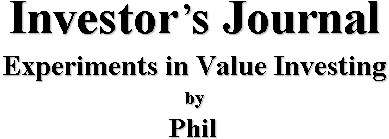Home
Previous
Next
June, 2024: 30

Disclaimer - IMPORTANT - Read this first!
| Investor's Journal is a diary focused strictly on investments and personal finance issues, primarily from a contrarian and retiree point of view. Follow along with an average guy's failures and successes as he learns, by trial and error, the fine art of value investing. |
6/30/24- Effective with the opening of the stock market tomorrow, our total liquid assets stand at $2,192,255, slightly above but virtually unchanged since the end of May total.
Our nest egg of all our assets, including real estate, is up merely $68,248, or 2.54% since the end of last year and is now worth $2,750,288.
The core 25 holdings for me and my wife remain as in our last entry. The plan is simply to post them through the end of 2024 or till they have been held a year and a day, whichever later. Once again, they are as follows:
Dividend Assets CHK; CMCSA; F; FINV; JWN; NXST; SD; WFC;
Value Assets ALSN; BOOT; CPE; GPOR; INMD; INSW; JKS; NEXN; PBF; SBOW; SWN; ZYME;
Growth Assets CELH; MNDY; NARI;
Exchange Traded Funds [ETFs] QQQ and VBR.
Our overall liquid assets are maintained in three categories: 1. Reserves plus money market funds; 2. Strictly no-sell-'ems (equity assets, like T and BRK/B shares, intended to be held till one or more estate heirs can manage them as they choose); and 3. Tradable stocks or equity fund holdings. Am hoping this third portion can beat the annual long-term average performance of the S&P 500 Index (10.64%, including dividends). For the first half of 2024, our tradable equities are up a little over 5.46%. If they do as well in the second half, they'll have attained a total return for January through December of 10.93%, a bit better than the market's long-term record.
In the last entry I noted that stocks might be evaluated based on per share price to intrinsic value. Stocks selling below their intrinsic value, everything else being equal, are on average better bargains and carry less risk than those selling for more than a conservative estimate of their true worth.
There is also another interesting concept that can be applied to equity assets, "aggregate yield." A stock's earnings yield is the reciprocal of its price to earnings ratio. Thus, dividing 100 by the P/E gives a person the earnings yield. A stock with a P/E of 8 has an earnings yield of 12.50%. This would compare favorably with a AAA U.S. corporate bond yield today of 5.14% or with its long-term average yield of 6.45%. Equities with P/E ratios of 5 have an earnings yield of 20.00% (100/5 = 20).
Taking such a value analysis one step further, we can add the earnings yield to a stock's dividend yield, for instance, 4.00%, for an aggregate yield. Hence, our equity with a P/E of 5 and that annual dividend would have an aggregate yield of 24.00%, clearly much better than what is typically available from bonds.
There is no guarantee, naturally, that particular stocks with relatively high aggregate yields will perform well, and each investor is advised to do his or her own due diligence and/or to consult an investment professional, yet such assets are probably deserving of our extra consideration in choosing a portfolio of quality securities.
Since the last entry, I have found these stocks with average aggregate yields of 20% or above and selling for less than the Guru Focus assessment of their intrinsic value:
ASC - Ardmore Shipping Corp.
CPA - Copa Holdings S.A.
PARXF - Parex Resources, Inc.
PETRY - Vibra Energia, ADR
REPX - Riley Exploration Permian, Inc.
TNK - Teekay Tankers Ltd.
Disclaimer and Disclosure Statement
Neither I nor Investor's Journal will be responsible for losses by anyone who obtained ideas from this site.
This diary is intended for personal interest and general information only. You are advised to do your own research (as well as to consult highly compensated professionals) before spending money on anything.
I know of no reason anyone should take my financial musings seriously. At best I am a dedicated amateur providing a bit of investment-related insight and entertainment, at worst an amusing diversion.
My wife, Fran, and I may at times own shares of some of the assets mentioned here. But neither of us receive any benefit from reference to them, unless you count the mutual misery when we get it wrong, or the opportunity to gloat when we get it right.